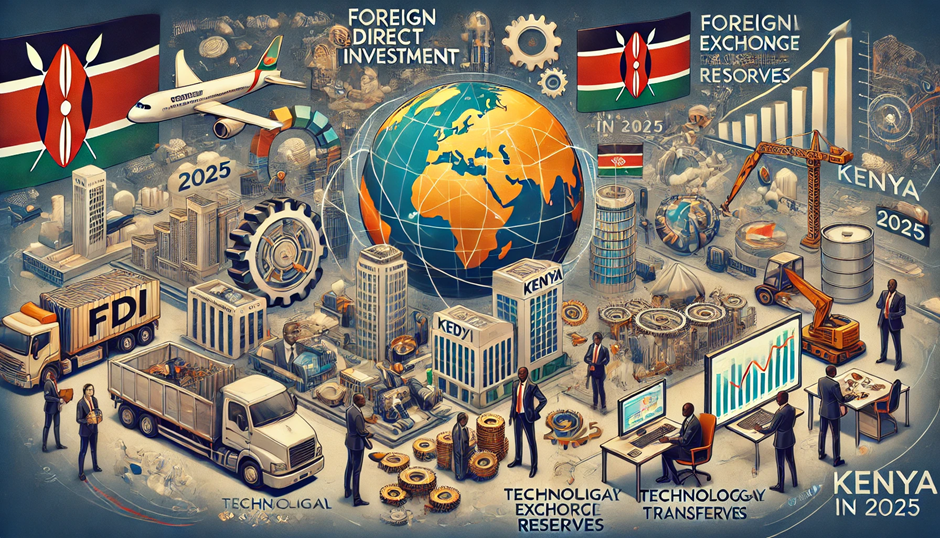The Future of Kenya’s Automotive Industry: Electric Vehicles and Beyond in 2025
Kenya’s automotive industry is poised for significant transformation in the coming years. As the world shifts toward sustainable transport solutions, Kenya is positioning itself to become a key player in the electric vehicle (EV) revolution. With the rise of EV technology, the government’s focus on sustainability, and a growing middle class demanding cleaner, more efficient transportation, Kenya’s automotive landscape is set to change drastically by 2025.
This blog explores the current state of Kenya’s automotive industry, the rise of electric vehicles, and other key innovations that will shape the future of transportation in the country.
The Evolution of Kenya’s Agricultural Export Sector: New Markets and Trends
Kenya’s agricultural export sector has long been a cornerstone of its economy, contributing significantly to GDP and foreign exchange earnings. With changing global markets and consumer preferences, the sector is evolving to meet new demands while navigating challenges such as climate change and trade barriers.
This blog explores the transformation of Kenya’s agricultural exports, emerging markets, trends, and strategies for sustainable growth.
Opportunities in Kenya’s Private Equity Sector: What Investors Need to Know in 2025
Kenya’s private equity (PE) sector has experienced robust growth over the past few years, driven by the country’s dynamic economy, expanding middle class, and rising investor interest in African markets. As we approach 2025, the opportunities in Kenya’s private equity sector are expanding, with key industries such as fintech, agribusiness, infrastructure, and healthcare offering high-potential returns.
This blog will provide insights into the opportunities that lie ahead for investors in Kenya’s private equity landscape, including key growth sectors, trends to watch, and factors that investors should consider when making investment decisions in 2025.
Navigating Kenya’s Economic Challenges in 2025: A Business Leader’s Perspective
Kenya’s economy in 2025 presents a mix of opportunities and challenges. As the country recovers from global economic disruptions, businesses face rising inflation, changing taxation policies, and fluctuating global markets. Navigating these challenges requires innovative strategies and a deep understanding of the local and global economic landscape.
This blog explores key economic challenges in Kenya, their implications for businesses, and strategies business leaders can adopt to build resilience and thrive.
Kenya’s Transport Sector: Innovations for Smart Cities and Sustainable Mobility in 2025
Kenya is on the brink of a transport revolution as it embraces new technologies, green solutions, and smart city innovations aimed at transforming urban mobility. With a rapidly growing urban population, the need for sustainable and efficient transportation systems has never been more critical. The year 2025 promises to see Kenya advance its ambitions for smart cities, where mobility is not just about convenience but also about sustainability, inclusivity, and technology-driven solutions.
This blog delves into how innovations in Kenya’s transport sector will shape smart cities and ensure sustainable mobility by 2025.
Kenya’s Fintech Boom: How Mobile Payments Are Reshaping Financial Services
Kenya has become a global leader in financial technology, driven by the widespread adoption of mobile payment systems like M-Pesa. These innovations have not only transformed how people transact but have also significantly boosted financial inclusion and economic development.
This blog examines the key drivers of Kenya’s fintech boom, the impact of mobile payments on financial services, and the challenges and opportunities that lie ahead.
Kenya’s Changing Labor Market: Preparing for the Jobs of Tomorrow
As Kenya approaches 2025, its labor market is undergoing significant transformations. The rise of automation, digital technologies, and new industries is changing the landscape of work, and Kenya is poised to adapt to these shifts. To ensure a thriving workforce in the future, it’s crucial for Kenya to invest in skills development, prepare for industry disruptions, and create policies that support the evolution of labor markets.
This blog explores the emerging trends in Kenya’s labor market, the jobs of tomorrow, and how the country is positioning itself to meet future workforce demands.
Kenya’s Agriculture: The Need for More Investment in Value-Added Products in 2025
Agriculture remains the backbone of Kenya’s economy, employing a significant portion of the population and contributing to a large share of export earnings. However, the country’s agricultural sector has traditionally been focused on the export of raw agricultural commodities such as tea, coffee, and horticultural products. In 2025, there is a growing need to shift towards the production of value-added agricultural products to maximize economic returns, enhance food security, and create sustainable jobs.
This blog explores why Kenya must invest in value-added agriculture, the potential benefits, and the strategic steps needed to achieve this transformation.
How Kenya’s Youth Are Driving Innovation Across Various Industries
Kenya’s youthful population is one of the country’s greatest assets, with approximately 75% of its population under the age of 35. This demographic is not only the driving force behind Kenya’s workforce but also the key to its growing innovation ecosystem. From tech startups and social enterprises to the fashion industry and agricultural innovations, Kenya’s youth are playing a pivotal role in shaping the country’s future.
As we approach 2025, young Kenyans are redefining industries, breaking traditional barriers, and leading the charge for transformative change. This blog will explore how Kenya’s youth are driving innovation across key sectors, their impact on the economy, and the opportunities for growth in these areas.
How Kenya’s Education System Is Shaping the Future Workforce in 2025
Kenya’s education system is undergoing significant transformations aimed at equipping students with the skills necessary to thrive in the dynamic job market of the future. As the world shifts towards digitalization, innovation, and a more knowledge-based economy, Kenya is adapting its curricula and educational infrastructure to meet these demands.
This blog explores how Kenya’s education system is shaping the future workforce, examining key trends, challenges, and opportunities for the next generation of workers in 2025.

 The Future of Healthcare in Kenya: Innovations and Trends for 2025
The Future of Healthcare in Kenya: Innovations and Trends for 2025 The Future of Wellness in Kenya: Biohacking and Personalized Nutrition
The Future of Wellness in Kenya: Biohacking and Personalized Nutrition The Hidden Dangers of Ultra-Processed Foods: A Call for Healthier Choices
The Hidden Dangers of Ultra-Processed Foods: A Call for Healthier Choices The Link Between Workplace Stress and Productivity: A 2025 Perspective
The Link Between Workplace Stress and Productivity: A 2025 Perspective How Technology Is Enhancing Maternity and Infant Healthcare in Kenya
How Technology Is Enhancing Maternity and Infant Healthcare in Kenya How AI and Telemedicine Are Transforming Healthcare Access in Kenya
How AI and Telemedicine Are Transforming Healthcare Access in Kenya Fitness Tech in Kenya: How Wearables Are Encouraging an Active Lifestyle
Fitness Tech in Kenya: How Wearables Are Encouraging an Active Lifestyle Digital Detox: How Reducing Screen Time Can Improve Mental Health in Kenya
Digital Detox: How Reducing Screen Time Can Improve Mental Health in Kenya Cultural Beliefs and Healthcare Decisions in Kenya
Cultural Beliefs and Healthcare Decisions in Kenya Childhood Obesity in Kenya: Causes, Prevention, and Solutions
Childhood Obesity in Kenya: Causes, Prevention, and Solutions



































































































